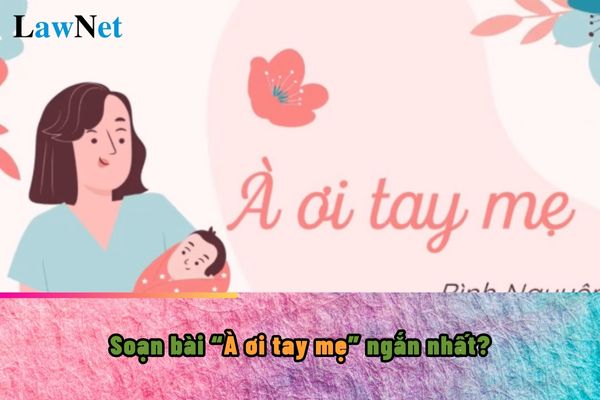What are guidelines on preparing the lesson "À ơi tay mẹ" for students in Vietnam? What are the regulations on Vietnamese language knowledge for grade 6 students in Vietnam?
What are guidelines on preparing the lesson "À ơi tay mẹ" for students in Vietnam?
Refer to the following guidelines on preparing the lesson "À ơi tay mẹ" for students in Vietnam.
|
Preparing the lesson "À ơi tay mẹ" * General Emotion: |
*Note: the information about the lesson "À ơi tay mẹ" is for reference only.

What are guidelines on preparing the lesson "À ơi tay mẹ" for students in Vietnam? What are the regulations on Vietnamese language knowledge for grade 6 students in Vietnam? (Image from the Internet)
What are the regulations on Vietnamese language knowledge for grade 6 students in Vietnam?
According to Subsection 2, Section 5 of the General Education Program for the subject of Literature issued together with Circular 32/2018/TT-BGDDT, grade 6 students will learn the following contents in the Literature subject:
*VIETNAMESE LANGUAGE KNOWLEDGE
- Simple words and compound words, compound and reduplicative words
- Polysemous words and homonyms
- The meaning of some common idioms
- The meaning of some common Sino-Vietnamese elements (e.g., bất, phi) and the meaning of words containing those Sino-Vietnamese elements (e.g., bất công, bất đồng, phi nghĩa, phi lí)
- Main components of a sentence: expanding the main components of a sentence with phrases
- Adverbial: features, functions of connecting sentences
- Uses of semicolons (mark boundaries between parts in a complex list); quotation marks (mark understanding of a word/phrase not in its usual sense)
- Rhetorical devices of metaphor, metonymy: characteristics and effects
- Paragraph and text: features and functions
- Selection of words and some sentence structures appropriate to conveying the meaning of the text
- Text types and genres
+ Narrative text: a composition recounting a personal experience, a composition narrating a folk tale
+ Descriptive text: a composition describing daily scenes
+ Expressive text: hexameter poetry; a paragraph recording emotions when reading hexameter poetry
+ Argumentative text: opinion, reasoning, evidence; a presentation of views on a phenomenon in study, life
+ Informative text: title, sapo, headings, bold text, numbers, and bullet points; a descriptive composition recounting an event; a record of an incident or a meeting, discussion
- Language development: phenomenon of borrowing words, loanwords, use of loanwords
- Non-verbal communication tools: images, data
*LITERATURE KNOWLEDGE
- Expressiveness of literary texts
- Details and the relationship between details in literary texts
- Topic, theme of the text; feelings, emotions of the writer
- Elements: plot, character, storyteller's voice and character's voice in legends, fairy tales, fables
- First-person and third-person narrators
- Formal elements of hexameter verse: number of syllables, number of lines, rhyme, rhythm
- Title, verses, stanza, rhyme, rhythm, language, and the effect of these elements in a poem
- Narrative, descriptive elements in poetry
- Form of recording, method of narrating events, first-person narrator in memoirs or travelogues
In addition, the materials used in the sixth-grade Literature subject include:
(1) Literary Texts
- Legends, fairy tales, fables, short stories
- Poetry, hexameter poetry
- Memoirs or travelogues
(2) Argumentative Texts
- Social argumentation
- Literary argumentation
(3) Informative Texts
- Composition recounting an event
- Record of minutes
- Content summary diagram
Are the grade 6 Literature textbooks in Vietnam required to be suitable for the teaching conditions at the school?
According to Article 3 of Circular 27/2023/TT-BGDDT on criteria for selecting textbooks:
Criteria for Selecting Textbooks
1. Suitable for the socio-economic characteristics of the locality.
2. Suitable for the conditions of teaching and learning at the educational institution.
The grade 6 Literature textbooks selected must be suitable for the teaching conditions at the school.

